Healthy Pizza
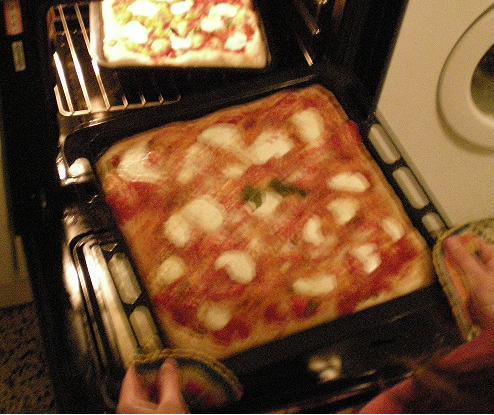
Healthy, quick and....wholemeal
Here's a quick recipe for anyone who loves pizza but wants to be healthy, or for anyone (it can happen) whose stomach gets upset by the yeast that's in pizza. Alternatively if you just need to make a quick pizza and would like a tasty change - this is for you!
Let me introduce you to the wholemeal, yeast free pizza. Here's what you'll need:
- wholemeal flour (4 large cupfuls),
- Extra Virgin Olive Oil (one tablespoonful for every cup of flour),
- luke warm water (half a cup or more),
- a sprinkling of salt or if you're cutting down on the salt you can use crushed white pepper instead (the absence of salt isn't missed).
Pizza dough
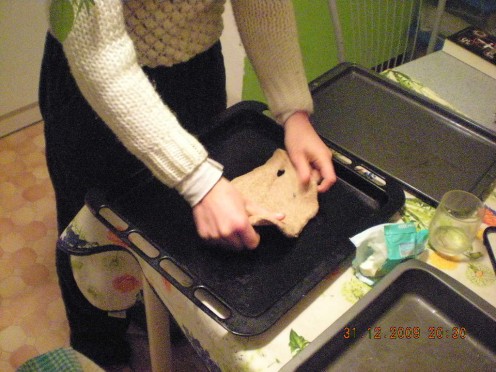
Procedure
Using a sieve sift the flour into a large bowl (the sifting lets in air which will help it rise later). Once this is done add the oil (depending on how much flour you're using), the salt or pepper and now get yourself a large cup of warm water (better if it's cold water heated slightly in pan and not from the hot tap).
Add the water bit by bit and while you're doing this knead the dough. Don't add the water all at once - you'll risk getting a sloppy mess. You may not need all the water or you may need more, but the end result shouldn't be dry nor sticking to your hands. Go with 'moistish'.
Usually, in making pizza, the kneading part is fundamental and requires a good deal of time but as this pizza has no yeast in it you can get away with the bare minimum and my results have been fine with just five to ten minutes kneading.
When this is done, press the dough in the bowl, cover the bowl with a damp teatowel and place it near the radiator or anywhere warmish. (This is to help it rise).
You should leave it where it is for at least an hour (even though, as there's no raising agent in it, it's not a big problem if it's less).
Afterwards, if you've made traditional pizza or bread before, you'll notice that it doesn't rise much, in fact hardly at all, but it will rise a bit and you'll find it lighter and easier to spread on the baking tray now.
Stretching out the dough
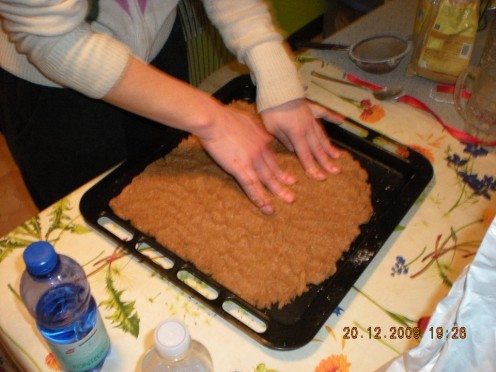
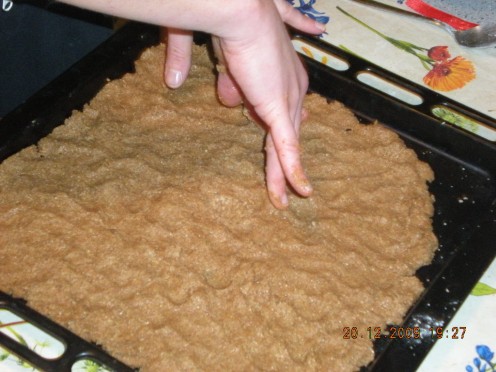
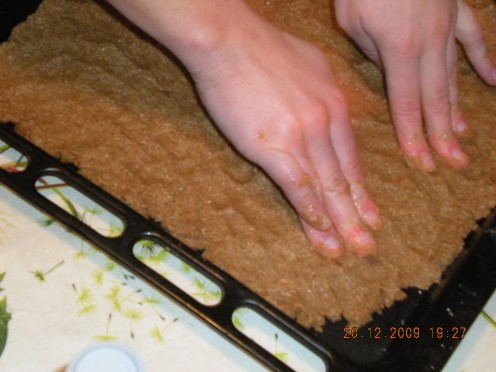
Stendere la pizza
'Stendere' pizza in Italian means you roll it out on the baking tray - but you don't 'roll' it because there is no rolling pin involved; you use your own hands to lay it out on the baking tray. Although you can use a rolling pin, this is the way my Napoletan friend recommended as the pizza comes out lighter and thinner.
How to lay out the pizza
You need to have a greased baking tray, rectangle or round - it's not important which. Use butter to grease it as oil makes the dough slip rather than cling to the tray.
Here's what to do: break off a small ball of dough from the dough and using the tips of your fingers, press it down on the baking tray and ease it across the surface until it covers the whole baking tray. As you do this press with the tips of you fingers quite vigorously - as if you were playing a Minuet on the piano - the dough should spread itself across the surface as you go. If the ball of dough isn't enough, take some more but as little as possible because the idea is to make the dough go a long way and finish up with a thin crust.
Once this is done put the baking tray with the base laid outside and start on another tray. (Put the tray in a warmish place and it will rise a bit more in the meantime.) You should get three or four trays of pizza from the dough you have (obviously less if you've used less flour) and it's always good to make a batch - you can freeze any left overs or have them the next day.
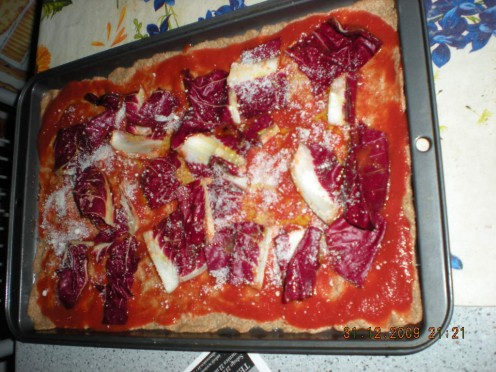
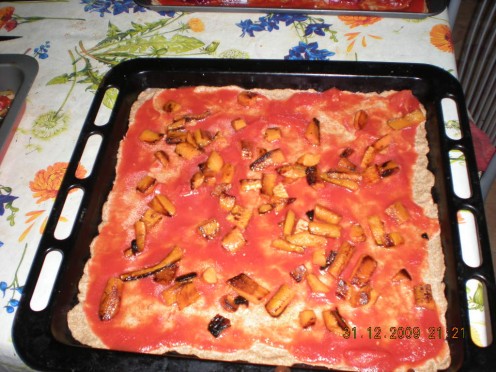
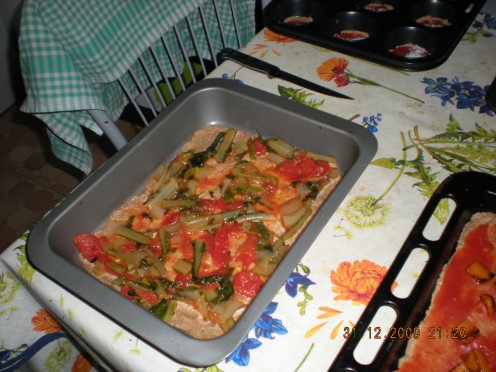
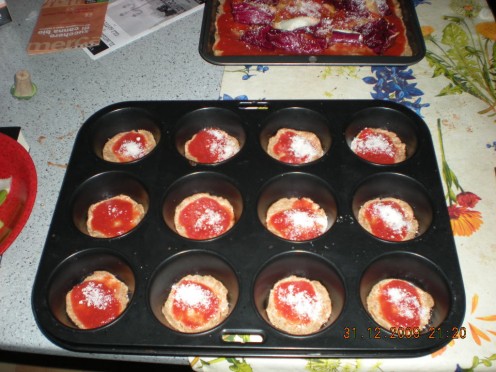
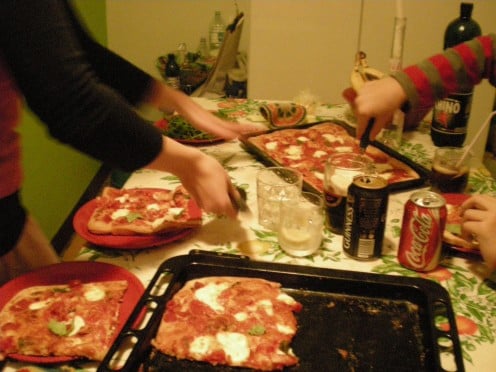
Topping
While you're busy with the dough take time to switch on the oven (180°c/356F).
When all the pizza bases are laid out you can start putting on the topping. You'll need tomato sauce - now wait! Not Ketchup - tomato sauce. You can make your own if you have a heap of tomatoes and fancy boiling them down with some water but more practical is using tinned tomatoes - I recommend tinned cherry tomatoes as they have more flavour. When you empty the tin on the pizzas you may need to add a smidgen of water as if the sauce is too thick it may dry out in the oven and it's always best to have a 'saucy' pizza. Add the cheese - mozzarella if you can get it but if not any cheese you like. (You can always go without if you like - add some basil or oregano though to give more flavour).
Quick tip - if you don't have any topping ingredients in, fear not - you can get by with just Extra Virgin Olive Oil (I'm banking on you having it in) - just drizzle it generously over the pizza base, put it in the oven and what comes out will be something like a 'focaccia'.
Oven
So now the oven is warm you can start putting in those pizzas - leave them twenty minutes but don't you run off to watch telly - you need to be keeping an eye on them. If you've got more than two pizzas from that dough, you should cook them in batches of two, maybe three. One should go on the top shelf and the other near the bottom (not too near or you'll get a black bottom!). Then after ten minutes rotate them - in this way they'll all have a crispy base and melted topping. You can also use a pizza stone when cooking which helps to give it that genuine Italian pizza taste (or so they say - I've never tried them).
When the twenty minutes are up - maybe more, maybe less, keep checking - out it comes and get your pizza cutter at the ready! I can assure you that if you've followed my instructions you won't even notice it's a 'healthy pizza' - but if you're not too interested in the 'healthy' part you can accompany it with a beer (as Italians do) but make sure it's very cold, very fizzy and 'blonde'!
Buon appetito!









